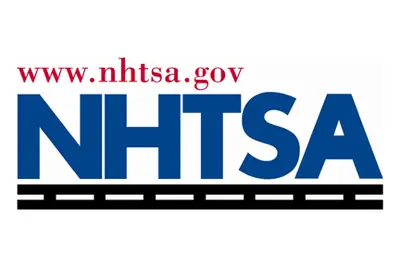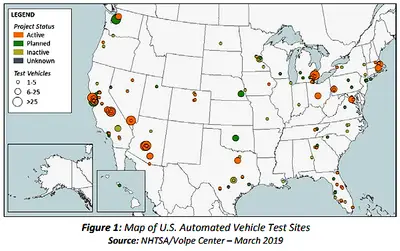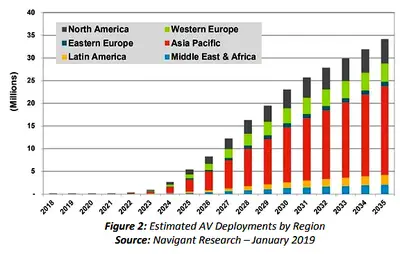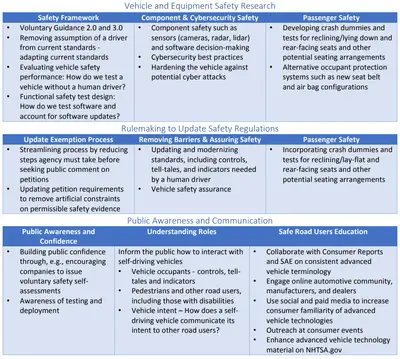NHTSA Explains Highly Automated or "Self-Driving" Vehicles
 |
What is the current state of the technology today?
At present, automated or “self-driving” vehicle technologies are in research and development. Developers are testing components and systems through simulation and modeling, controlled track testing and limited on-road testing with vehicle operators and monitors.
As of March 2019, NHTSA had identified on-road testing and development in 34 States and the District of Columbia as shown in Figure 1.
When will self-driving vehicles be available?
Self-driving vehicles are a future technology concept rather than one that you’ll find in a dealership in the next few years. Several companies have announced plans to deploy their vehicles in company owned, operated and maintained ride-sharing or delivery fleets.
A variety of technological hurdles must be overcome before these types of vehicles could be available for sale in the United States. NHTSA is committed to supporting the innovators who are developing these types of vehicles to ensure their safe testing and deployment before they are available to consumers. Figure 2 shows a recent estimate on deployment rates worldwide.
What safety regulations apply to self-driving vehicles?
All motor vehicles and motor vehicle equipment are regulated by NHTSA, including highly automated vehicles, partially automated vehicles, and vehicle equipment.
Self-driving vehicles are subject to existing Federal Motor Vehicle Safety Standards. More importantly, they are also subject to NHTSA’s broad authority relating to safety-related defects. This authority requires the recall of vehicles or equipment containing defects that pose an unreasonable risk of crashes occurring, or of death or injury in a crash. This authority applies equally to current and emerging vehicle technologies such as those in self-driving vehicles—including systems not covered by a Federal Motor Vehicle Safety Standard.
What is NHTSA doing to facilitate the safe deployment of self-driving vehicles?
NHTSA is working to update existing regulations and standards and develop modern, flexible performance standards for safe motorized vehicles. At the most basic level, a safe vehicle must be able to achieve four
performance goals:
-
• Avoid Crashes
• Protect Occupants
• Obey Traffic Laws and Norms
• Complete Intended Travel Mission
NHTSA is working with industry and academia and performing research on how self-driving vehicles could reliably and objectively demonstrate that they can achieve these four critical performance goals. NHTSA is also developing consumer communications strategies. The agency is seeking to ensure its international counterparts do not regulate prematurely, and will take a highly performance-oriented approach if it becomes appropriate to regulate.
NHTSA is taking an agency-wide approach to ensuring the safe deployment of self-driving vehicles. Our activities can be categorized into three main areas: research, rulemaking and communications.





